
Êîíñòðóêöèè àíòåíí
SM0DTK, Martin
Building antennas has always been of great interest for me and there are many constructions that I have found pleasure in. Here you can see some of them with modest comments.
28/21 MHz yagi.This antenna was built to match the peak of suncycle 22. It works as a 3 element yagi on 21 MHz and as a 4 element on 28 MHz. It uses different matching for each band and SWR is 1:1 on both bands. As capacitors in the Gamma matching I use short pieces of RG8 Coax cable.

Bobtail for 10 MHz.It is hard to work DX from 60 degrees north during suncycle minima. The only chance is on lower bands and spaces outside my house could take a Bobtail for 10 MHz. As it is fed in the upper corner it is perfect for 50 ohms matching which gives me perfect SWR. The cornerfeed method results in a different radiation pattern compared to Bobtails fed at the bottom of the middle tail. Cornerfeed Bobtail has a pattern that looks like a cloverleaf meaning that it works well in all directions.
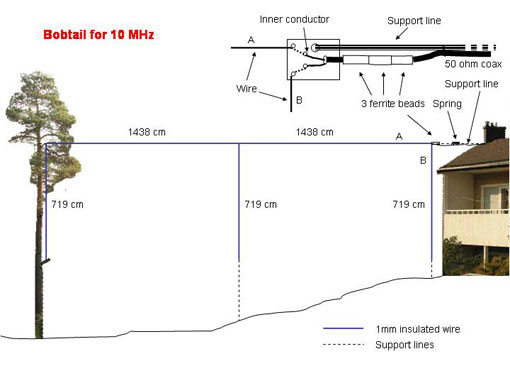
GP for 7 MHz.I used a loop on 7 MHz and it worked fine except in northern and southern direction. So I decided to put up a GP to cover all directions. The radiator is attached to a tree and at the top it has a fishing rod with a hook to fix it to the tree.
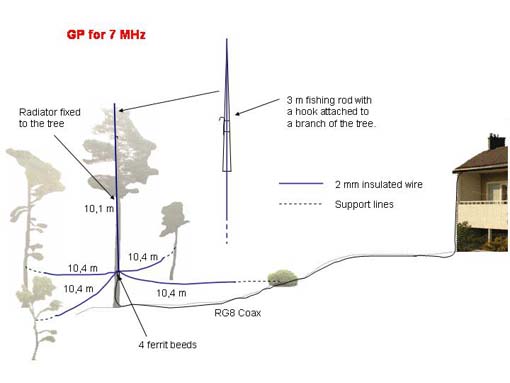
GP for 14 and 18 MHz.Limited space for antennas made me to make a GP for 14 and 18 MHz. Switching bands is done by controlling 2 relays which are housed in a plastic box placed at the bottom of the radiator. There are 4 radials for each band. SWR is perfect for both bands and for 18 MHz condenser C will do the trick.
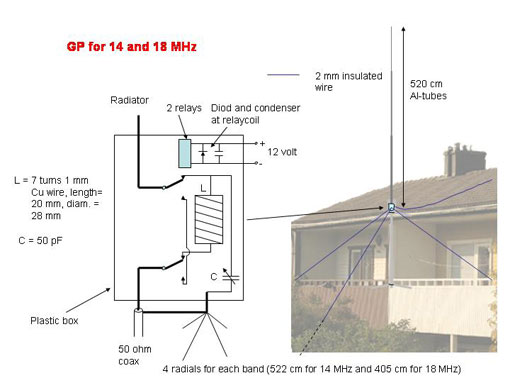
Reversible deltaloop for 7 MHz.When beeing active from Gotland Island (IOTA EU-020) I have a lot of space to put up antennas. Pretty high trees are perfect for support points. When YV0D (Aves Island) should be active in july 2004 I constructed a 2 el loop for 7 MHz and put it up in direction to the Caribbean. By adjusting a condenser I could get some gain and there were no problem working them with S9 signals.
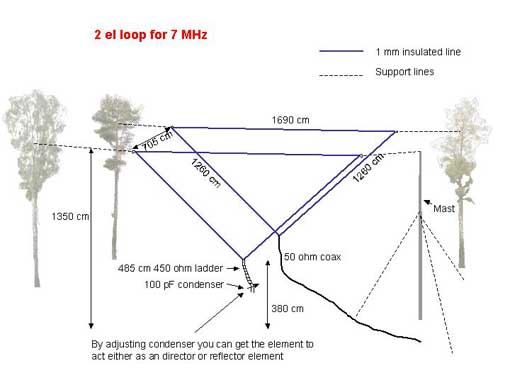
3 el wire yagi for 21 MHz.I got a nice pile-up when using 100 W and this antenna pointed to Japan. It is extremly lightweight so erecting it at the top of a 10 m al-mast mast is done by hand.
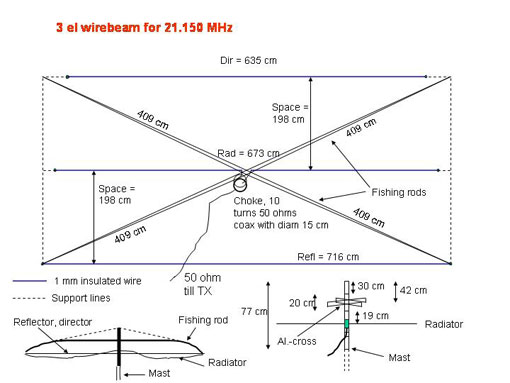
Bobtail for 7 MHz.The Bobtail fed at the bottom of the middle tail and the next antenna the Double Extended Zepp behave in a very same manner. The gain and the radiation pattern is comparable but if I have to choose I pick the Double Extended Zepp.
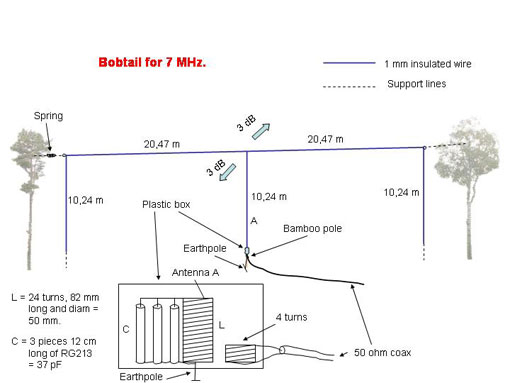
Double Extended Zepp for 7 MHz.Normally the whole antenna is horizontal but I bent down the ends of the antenna to fit between the two trees and it worked nicely.
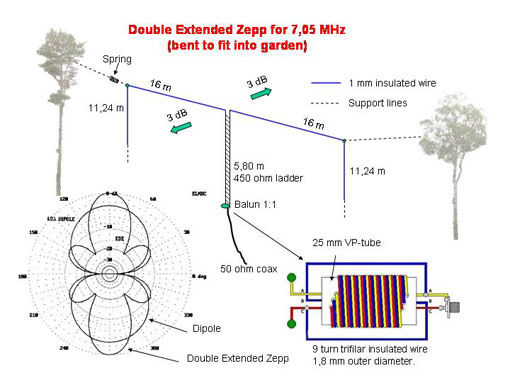
Hexbeam for 21 MHz.In a contact with a KL7-station I first heard about the Hexbeam antenna. He said it looks like an umbrella turned downwards without cloth and can withstand strong winds. I got curious about the antenna and constructed one for 21 MHz. It worked at the first try and was a very lightweight beam antenna.
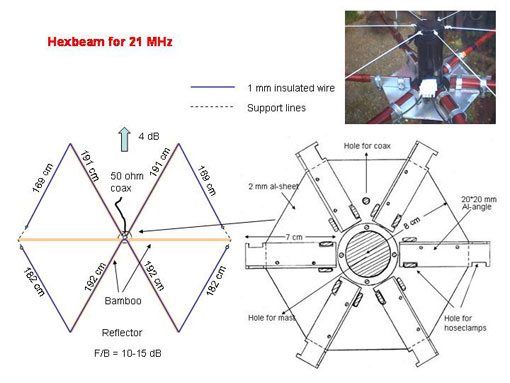
Moxon antenna for 14 MHz.This antenna is a very kind one and often works at the first try. I have tried several types ( vertical and horizontal) on different bands and all have worked nicely.
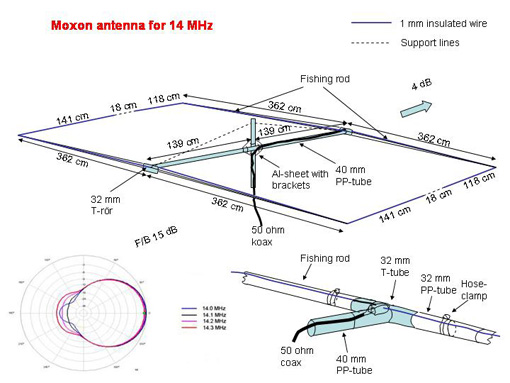
Reversible Moxon antenna for 7 MHz.This antenna is also called FBA (Flip Beam Antenna) and direction of the antenna can be changed using relays or a switch. Signals increase/drop 3-4 S-units when changing direction.

Spitwire for 7 MHz.Talking about silent antennas this one will count. The antenna is based upon a construction by W1FV and K1VR called "the Spitfire" using the mast as radiator. As I use wire for the radiator I think Spitwire is more adequate. It uses switches to enable the antenna to change direction. The gain is about 4 dB and the F/B is about 20-25 dB, very excellent.
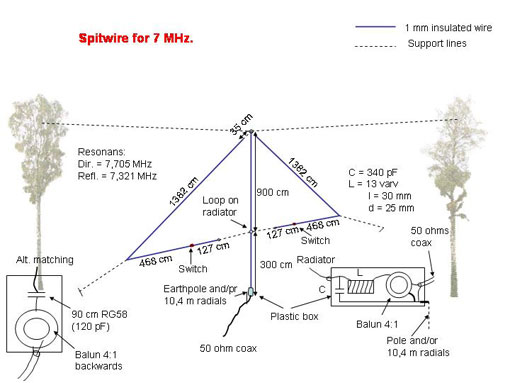
Fork antenna for 7 MHz.Even a more silent antenna is the Fork antenna. it has a F/B value about 25-30 dB and a gain about 3-4 dB. With a matchingbox containing 1:6 balun och condensers you can obtain a SWR 1:1.
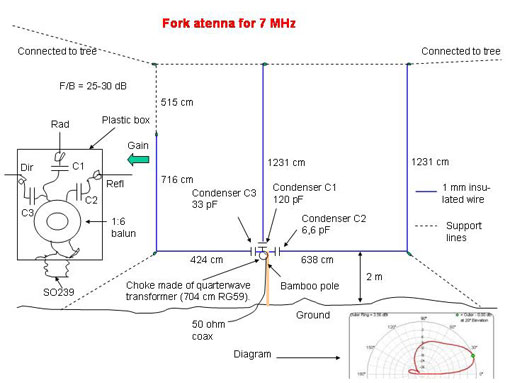
Veebeam antenna.This antenna is working nicely on all bands using an antenna tuner between the 600 ohm ladder and the transceiver. Some gain is also obtained.
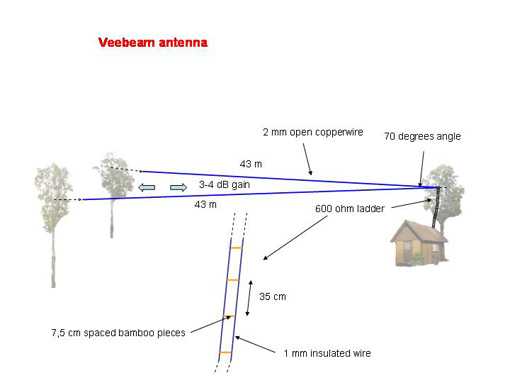
Vertical Moxon antenna for 28 MHz.There are some reasons why you should endfeed your vertical Moxon antenna. You don´t need a hanging coaxcable from your radiator. You get an antenna with less windbreak and an antenna in good balance. You just need to voltage-feed the radiator with a simple LC parallel resonant circuit like you feed a Bob Tail antenna or a Half Square antenna.

Vertical Moxon antenna for 14 MHz.This vertical Moxon is also endfeded. The parallel resonant circuit in this antenna uses a piece of RG8 coaxcable as a condensor. Remember to keep the open end of the RG8 secured from water (rain) because of high voltage. On 25 june 2011 this one helped me with FO/F6CTL in Marquesas island.
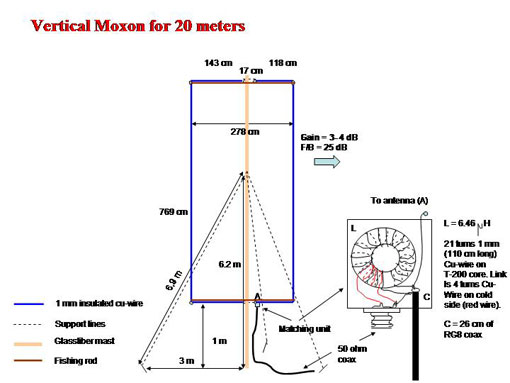
Halfsquare antenna for 10 MHz.Due to QRM into my neigbours HI-FI speakers using the Bobtail described above I replaced it with a Halfsquare antenna placed 15 meters out of houses. Using a link with capacitor in serie the SWR is perfect zero. It works fine even to the south but best directions are west/east. The horizontal part of the antenna is hanging in south/north direction.
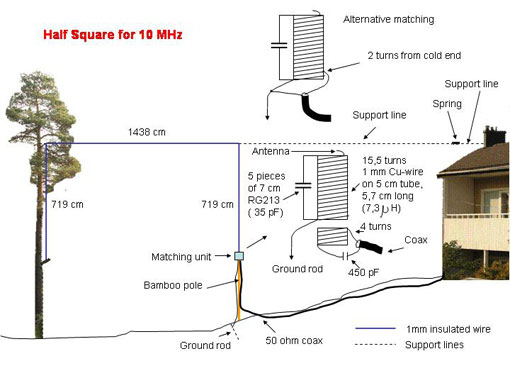
Linear loaded antennas.When space is limited one has to design and build shortened antenna. One way to do this is to use the linear loaded koncept. By using 450 ohms ladder lines as stubs the construction is a piece of a cake. I have used a griddip meter to adjust the lengths of the stubs to obtain the demanded frequency. Below you can find dimensions for antennas for 7, 14 and 28 MHz. All antennas are 70 % of normal lengths.
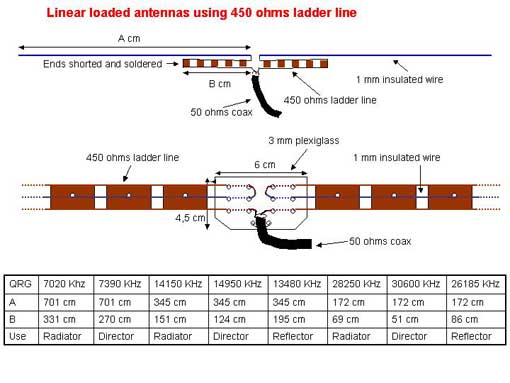
Rotatable loop for 14 MHz.This simple antenna is working extremly well. Compared to a Double Extended Zepp at same hight and same direction it has more gain and less noise. So it is a very attractive antenna for portable use on both receiving and transmitting side.
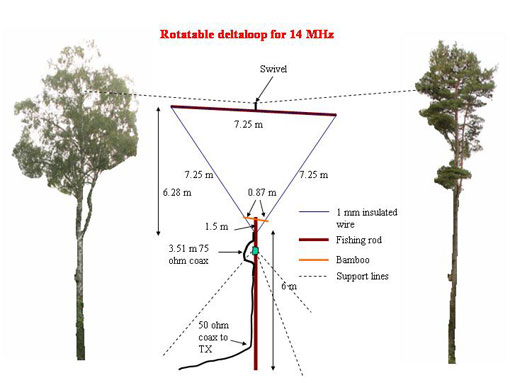
Vertical dipole for 14 MHz.Tired of noise from your house? Well, one way to get rid of it is to move your antenna into the wood. One of the real simple antenna to build and to erect is a vertical dipole. If you use a tree as a tower it is really a piece of a cake. A quater wave electrical length of 75 ohm (3.5 m) is used to match 50 ohm coax to the balun and antenna. The antenna has low gain but also very low elevation angle, 16 degrees, which is good for long distance QSO´s.
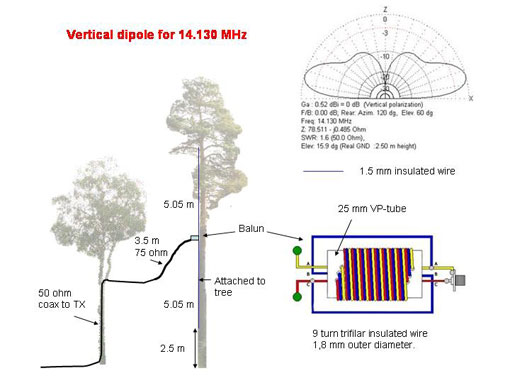
Mini Horse (MH)-antenna.- kicks like a grown-up horse
- takes the space of a pony
- broad as a highway
Ever looked for an antenna which has good gain, nice F/B, 50 ohms matching, excellent bandwidth, small turning radius and great mechanical stability? This antenna is for you! If you need a nec-file to play with just send me a mail.
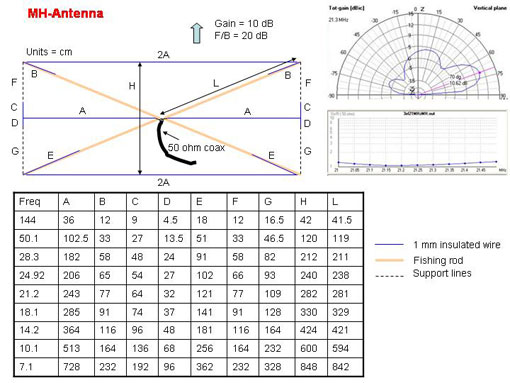
Compact Moxon antenna for 7 MHz.This antenna only needs 2 trees or masts to be hanged up in the air. It works nice with about 5 dB gain and 13 dB F/B hanging 12 meters above ground. More gain and better F/B if you can put it higher.
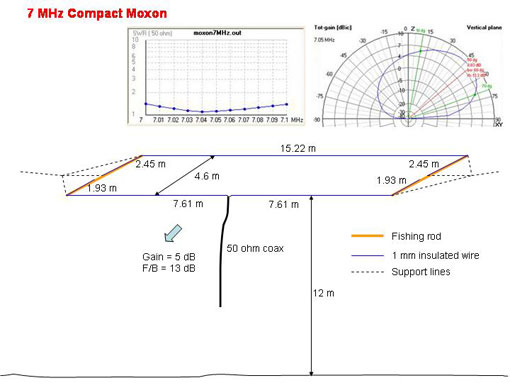
A 40/30/20 meter vertical on a flagpole.If you are in a hurry getting on the air or don´t want to disturb your neighbours with ugly antennas this antenna can be the solution. It is a vertical tribander fixed to the flagpole with radials on the ground. Traps are made of coax cable using VE6YP coax trap program.
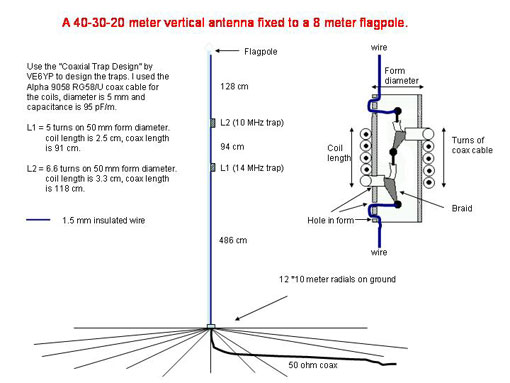
A 17/15/12/10 meter vertical on a fishing rod.Vertical antennas with only 2 elevated radials are simple but also quite good antennas for DXing. Another advantage is that it can be placed where there is no good ground or at the edge of your lawn so you can cut your grass without thinking of radials on ground. The traps also shortens the antenna a bit.

A 40 meter vertical with 2 elevated radials.As mentioned above vertical antennas with 2 elevated radials are simple and very cheap antennas for DX-ing. This one works fine from 7.0 to 7.2 with SWR < 1.5. If you use bare wire you should prelong the elements with 4%. On 15 september 2010 I worked ZS8M using this antenna.
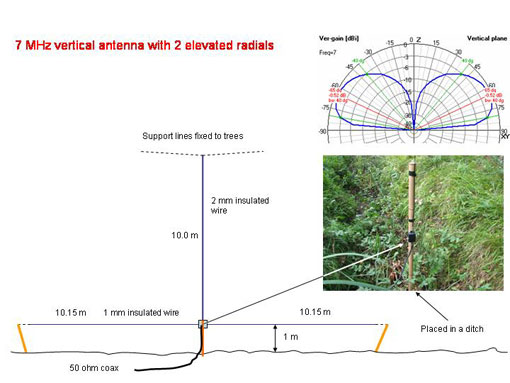
A reversible vertical for 15, 12 and 10 meters.If you use the same concept as above and apply some electrical short circuit units (6 pieces) you will get a reversibel antenna for the higher bands. This one helped me with VU4PB and 5M2TT on those bands.

Slope Loop for 10 meters.This antenna is in perfect balance focused to a mast by some fishing rods. The antenna is a 2 el Delta Loop with sloping elements. The gain of the antenna is like a 3 element yagi and the front to back ratio is about 8 dB.
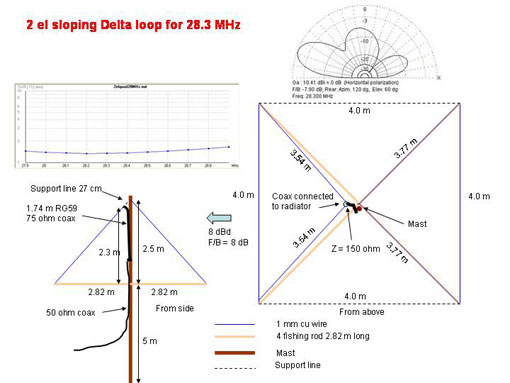
2 el phased vertical for 40 meters.Combining 2 verticals with 2 elevated radials each and 3 pieces of coaxcables gives you a phased vertical. Gain is 2-3 dB over a simple vertical and F/B is about 15 dB.

2 el Diamond Loop for 10 meters.This antenna might be the smallest 2 element antenna with a turning radius less then 1.6 meters. It gives a gain of 4 dB over a dipole and the F/B is about 15 dB. It needs a balun transformer 2.25:1 to match the 20 ohm impedans at the loading point.
